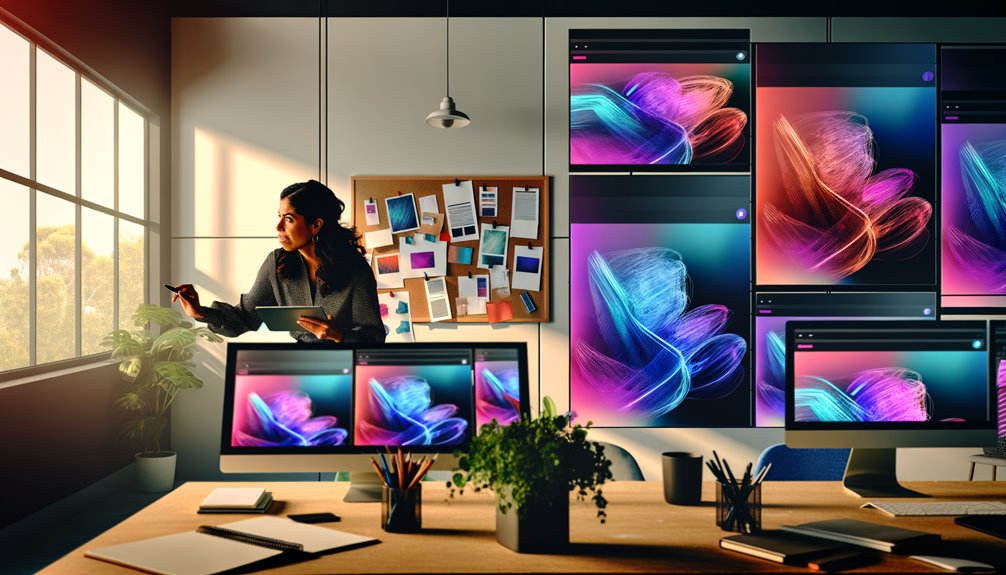
As the digital landscape evolves, web design in 2025 will demand a strategic approach to emerging trends. Integrating AI for personalized experiences, prioritizing minimalist aesthetics, and enhancing engagement through micro-interactions will be essential. Additionally, accessibility and sustainability will play significant roles in shaping user perceptions. Understanding these elements is imperative for any brand aiming to thrive. What specific strategies will define success in this rapidly changing environment?
Key Takeaways
- AI integration will enhance personalization, creating tailored content that resonates with individual user preferences and fosters deeper emotional connections.
- Minimalist design will continue to reduce visual clutter, promoting ease of navigation and improving user experience with clear typography and negative space.
- Mobile-first and responsive design will prioritize seamless interactions across devices, ensuring accessibility and user engagement as digital landscapes evolve.
- Micro-interactions will enrich user experiences, providing feedback loops that enhance enjoyment and encourage continued exploration of websites.
- Sustainable practices in web design will become essential, demonstrating environmental responsibility and enhancing brand identity to connect with conscious consumers.
Immersive User Experiences With AI Integration
As the digital landscape evolves, the integration of artificial intelligence is poised to revolutionize user experiences, making them more immersive and engaging than ever before.
AI personalization allows websites to dynamically adapt content to individual preferences, creating a unique journey for each user. This tailored approach not only enhances user satisfaction but also fosters a deeper emotional connection. Additionally, iterative development based on user feedback ensures that the personalization process continually improves, leading to even more meaningful interactions.
In addition, immersive storytelling powered by AI captivates audiences, drawing them into compelling narratives that resonate on personal levels. Furthermore, the importance of local content in improving search visibility highlights how AI can enhance user engagement through relevant and tailored experiences.
Emphasis on Minimalist Design
The shift toward immersive user experiences through AI integration is complemented by a growing emphasis on minimalist design. This design philosophy champions freedom by liberating users from visual clutter, allowing them to navigate effortlessly. By skillfully utilizing negative space, designers create an inviting atmosphere that enhances focus on content. Strategic typography choices further amplify this clarity, ensuring that messages resonate without distraction. As brands endeavor to connect authentically with their audience, embracing minimalism becomes essential. This trend not only reflects a modern aesthetic but also empowers users, fostering a sense of control and engagement in their digital interactions. Additionally, the focus on Core Web Vitals ensures that minimalist designs do not compromise performance and accessibility. By prioritizing SEO-optimized practices, companies can enhance their online visibility while maintaining an elegant and straightforward user experience. Minimalism is the future.
Dark Mode and Its Benefits
Dark mode has rapidly emerged as a pivotal feature in web design, offering users a visually soothing alternative to traditional light interfaces.
The dark mode benefits extend beyond aesthetics, enhancing user experience by reducing eye strain and increasing battery efficiency on mobile devices. Furthermore, accessible tap targets are crucial in ensuring that interactive elements remain easily usable in dark mode.
As user preference shifts towards more comfortable viewing environments, designers must embrace this trend to stay relevant.
Implementing dark mode not only caters to individual choices but also fosters an inclusive digital space, empowering users to personalize their online interactions.
For innovative designers, adopting dark mode is essential to meet evolving demands and enrich user satisfaction. Additionally, recent CSS accessibility improvements highlight the importance of designing for diverse user needs, making dark mode an even more critical consideration in modern web design.
Micro-Interactions for Enhanced Engagement
Micro-interactions captivate users by adding layers of engagement to the web experience, transforming mundane actions into delightful moments.
These subtle design elements create essential feedback loops, allowing users to feel connected and informed during their interactions. By incorporating micro-interactions, designers can boost user delight, making every click, swipe, and hover feel rewarding.
This heightened engagement fosters a sense of freedom, as users navigate with ease and enjoyment. In 2025, embracing micro-interactions will not only enhance the aesthetic appeal of websites but also empower users, ensuring their experiences resonate deeply and encourage continued exploration.
Accessibility as a Design Priority
As user engagement becomes increasingly sophisticated, prioritizing accessibility in web design emerges as a fundamental responsibility for designers.
Implementing inclusive design guarantees that websites cater to diverse users, including those with disabilities. By embracing assistive technology, designers can create experiences that empower all individuals, fostering a sense of freedom and independence. Furthermore, conducting an accessibility audit can help identify and address potential barriers to user interaction.
Accessibility should not be an afterthought; rather, it must be integrated from the outset, enabling seamless interaction for everyone. By championing accessibility, designers not only adhere to ethical standards but also expand their audience, ultimately driving engagement and loyalty.
Additionally, ADA-compliant web solutions ensure that websites meet essential standards, further enhancing user experience.
The future of web design lies in inclusivity, enhancing the digital landscape for all.
Fluid and Responsive Layouts
Fluid and responsive layouts are essential for delivering a seamless user experience across all devices in 2025.
By implementing adaptive grid systems and adopting a mobile-first design approach, designers can guarantee that content is not only visually appealing but also functionally efficient. Additionally, dynamic content adjustment will empower websites to meet the diverse needs of users, making this design strategy a critical focus for future web development. Furthermore, ensuring compliance with Google’s Core Web Vitals is crucial for optimizing mobile performance and maintaining user engagement. Ultimately, search engine optimization (SEO) techniques will play a vital role in enhancing the visibility of these responsive websites in search results.
Adaptive Grid Systems
A significant shift in web design is evident with the rise of adaptive grid systems, which seamlessly blend fluid and responsive layouts to enhance user experience.
These systems offer unparalleled grid flexibility, allowing designers to create dynamic interfaces that adapt to various screen sizes. This adaptability reflects the transformative power of CSS in modern web design.
By prioritizing visual hierarchy, adaptive grids guarantee that essential content stands out, guiding users effortlessly through the site.
This approach not only fosters engagement but also empowers users by delivering a tailored experience.
As designers embrace these innovative frameworks, they will reveal new possibilities for creativity and freedom, making adaptive grid systems a cornerstone of modern web design in 2025. Additionally, utilizing CSS frameworks can significantly streamline the design process, providing pre-designed components that enhance functionality and aesthetics.
Mobile-First Design Approach
Recognizing the growing dominance of mobile devices in everyday life, the mobile-first design approach has become an essential strategy for web designers aiming to optimize user experience.
This approach prioritizes touchscreen optimization, ensuring that websites are intuitive and responsive across various devices. By focusing on mobile navigation first, designers create seamless interactions that empower users to explore with ease. Additionally, professional web design significantly correlates with business success, making it crucial for companies to adopt this strategy.
With fluid and responsive layouts, content adapts effortlessly to different screen sizes, promoting freedom in how users engage with websites. Embracing this strategy not only enhances accessibility but also aligns with the evolving digital landscape, making it indispensable for successful web design in 2025. Additionally, a well-designed website boosts credibility and increases user engagement, further solidifying its importance in today’s market.
Dynamic Content Adjustment
The increasing emphasis on mobile-first design naturally leads to the necessity for dynamic content adjustment through fluid and responsive layouts. This approach empowers websites to deliver real-time personalization, ensuring that users encounter context-aware content tailored to their preferences and behaviors. By leveraging middleware options, businesses can create adaptive designs that enhance functionality and responsiveness.
By adopting these adaptive designs, businesses can create immersive experiences that resonate with users across devices, fostering engagement and loyalty. Responsive layouts not only enhance usability but also reflect a commitment to freedom, allowing each visitor to navigate seamlessly. As web design evolves, embracing dynamic content adjustment will be essential for those seeking to captivate audiences in an ever-changing digital landscape. Additionally, ensuring ADA compliance for inclusivity will further enhance user experience and accessibility.
Sustainable Web Design Practices
Sustainable web design practices are rapidly becoming essential for progressive designers and businesses alike. By adopting eco-friendly hosting solutions, organizations not only reduce their carbon footprint but also appeal to environmentally conscious consumers.
Implementing carbon offsetting initiatives further enhances a website’s sustainability impact, allowing businesses to take responsibility for their emissions. Designers who prioritize these practices demonstrate a commitment to a healthier planet, fostering a sense of freedom for users who value sustainability. Additionally, a strong brand identity can amplify the efforts of sustainable design, helping businesses connect with environmentally conscious consumers and stand out in the competitive landscape.
As the demand for responsible design grows, integrating these principles will empower creators to lead the way towards a more sustainable digital future, setting them apart in a competitive landscape.
Frequently Asked Questions
How Can I Measure the Effectiveness of My Website’s Design Trends?
To measure a website’s design effectiveness, one should gather user feedback and analyze design metrics. This approach empowers website owners to make informed decisions, ensuring their design resonates with users and achieves desired goals efficiently.
What Tools Can Assist in Creating Immersive User Experiences?
To create immersive user experiences, leveraging advanced design tools like Figma, Sketch, and Adobe XD is essential. These tools empower designers to innovate, fostering creativity and ensuring users engage deeply with enthralling, interactive interfaces that inspire freedom.
How Do I Ensure My Website Remains Accessible for All Users?
To guarantee accessibility for all users, embracing inclusive design principles and actively seeking user feedback is essential. This approach fosters an environment where everyone can engage freely, unfastening the full potential of the website’s offerings.
What Are the Environmental Impacts of Web Design Practices?
The environmental impacts of web design practices are significant; adopting sustainable design reduces the carbon footprint of websites, promoting ecological responsibility. Embracing such practices empowers freedom, enabling creators to contribute positively to the planet’s future.
How Can I Incorporate Dark Mode Into My Existing Website?
Incorporating dark mode enhances user experience by catering to user preferences, reducing eye strain, and conserving battery life. Embracing this feature aligns with modern design principles, ultimately empowering users to choose their ideal viewing environment.
Conclusion
In 2025, embracing these web design trends is not just advantageous; it’s imperative for brands aiming to thrive in a competitive digital landscape. By integrating AI for personalized experiences, prioritizing minimalist aesthetics, and committing to sustainability, businesses can enhance user engagement and strengthen their identity. Additionally, focusing on accessibility and responsive layouts will guarantee inclusivity and adaptability across devices. Adopting these strategies will position brands at the forefront of innovation, ultimately driving growth and success.

Backlink-Building-Vs-Digital-Pr-Key-Differences
See how backlink building and digital PR differ in enhancing your online presence, and discover which strategy might be the key to your success.

Benefits-Of-Using-Local-Web-Designers
Discover how local web designers can elevate your business’s online presence, but what unique advantages do they offer that you might be missing?

Choosing-The-Right-Platform-WordPress-Vs-Wix-Vs-Squarespace
Just when you think choosing a website platform is simple, discover the unique strengths of WordPress, Wix, and Squarespace that could transform your online presence.

Congrats-On-The-New-Website-Now-What
Optimizing your new website requires strategic steps; discover the essential tactics that could transform it into a thriving online presence.

12-roofing-keywords-you-could-actually-rank-for
The top 12 roofing keywords could transform your online presence, but which ones will truly elevate your business above the competition?

Home-Care-Websites-Best-Practices
Learn essential best practices for home care websites that can elevate your online presence and captivate your audience—discover what sets successful sites apart.
